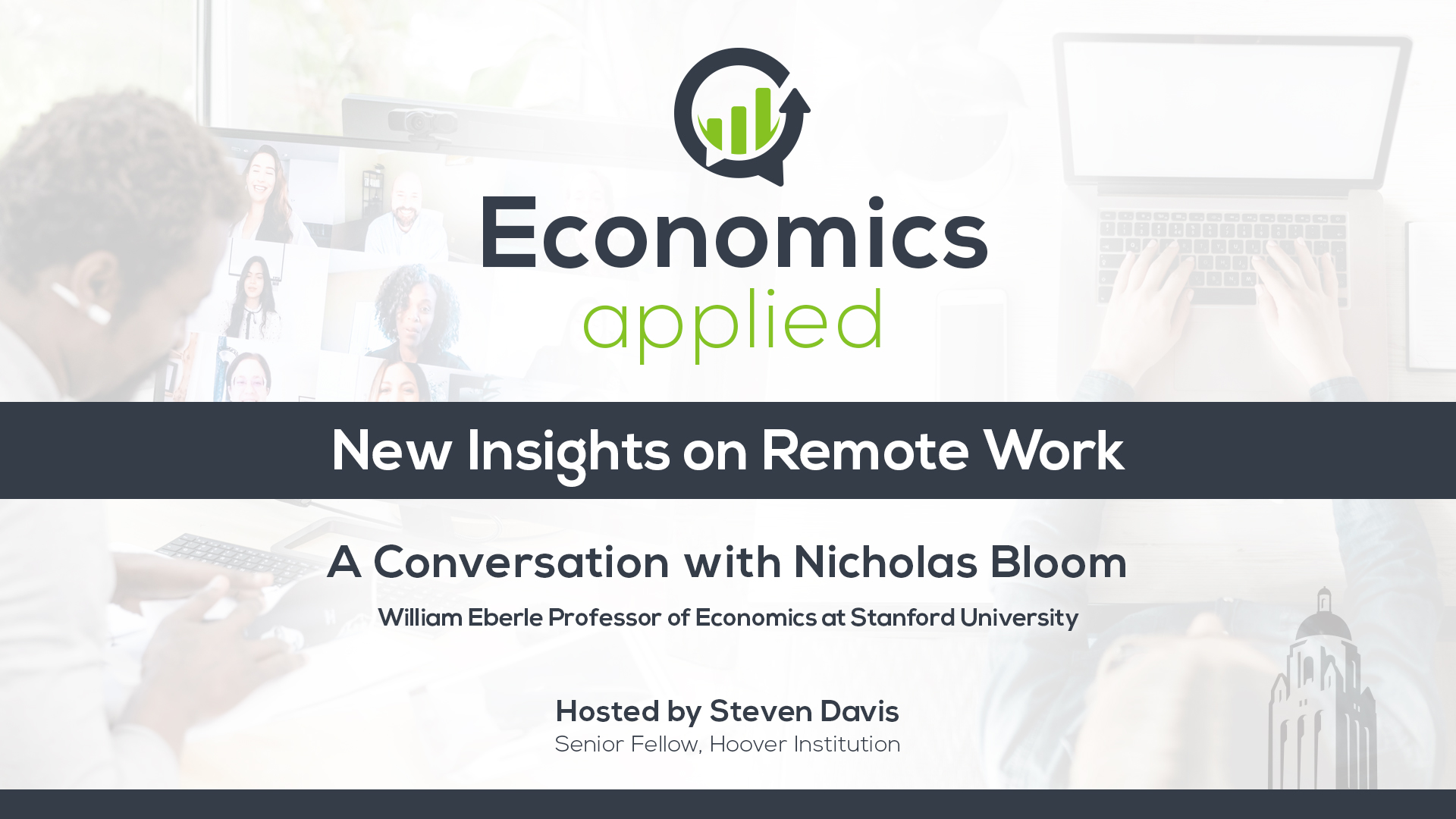Hoover Senior Fellow Steven Davis and Stanford Economics Professor Nick Bloom review insights from the latest research on remote work, drawing on a recent conference at Stanford University. Steve and Nick discuss Return-to-Office mandates (RTOs) and their impact on company performance, and long-distance CEOs and why companies hire them. They also explore how remote work facilitated a boom in business start-ups, recent employment gains among people with disabilities, the high value of flexible working arrangements for parents, hard times for burglars, good times for golf, and more.
WATCH THE VIDEO
>> Steven Davis: Welcome to Economics Applied, a podcast sponsored by the Hoover Institution. My name is Steven Davis, and I'm here today with my good friend, Stanford colleague, longtime research collaborator and famous work-from-home guru Nick Bloom. Thanks Nick, it's great to have you on the show again.
>> Steven Davis: So earlier this month you and I, we ran a three-day conference at Stanford on the implications of remote work.
It was with generous and gracious support from the Stanford Institute for Economic Policy Research and the Hoover Institution. And we saw many great papers and presentations, I think we had something like 28 in all, and we're gonna chat about some of them today. Before we dive in though, I just want to give a shout-out to our co-conspirators in organizing the conference.
So there's Jose Maria Barrero, Raj Choudhury, Natalia Emanuel, and Emma Harrington. Hats off to all three of them for helping us organize a great conference and dealing with you and me, which can be challenging. So Nick, let's start with a topic that's been very much in the news, which is Return to The Office mandates, RTOs for short.
What did we learn about RTOs at the conference?
>> Nicholas Bloom: So there were four papers related to RTOs at the conference, pretty impressively collected data. They looked at up to 3,000 US firms, so the Russell 3,000. Now basically any public listed firm you've ever heard of is in the Russell 3,000 and many others as well.
And they looked at what happens around RTO mandates. So to be clear, this includes both if you're fully remote and you ask people back one day a week. And what I think people have in mind is Amazon's just done, they've gone from three to five days. And they picked up 1,200 of them roughly.
So they scraped news and all sorts of different sources. What do they find overall? A bunch of stuff. So first finding is bad performance is a predictor of an RTO mandate.
>> Steven Davis: I love this finding. So you do an RTO when things are going badly?
>> Nicholas Bloom: Yeah, I mean you can interpret this several ways.
There's a positive way, yes, things are performing badly and you try and change it. There's a more negative view of now's the time to try and distract, in the next earnings call, I wanna blame it on something else. There's this joke of the grab bag of CEOs will blame bad weather, union strike, bad luck.
And at some point they pull out the excuses called working from home. And so you throw in the RTO-
>> Steven Davis: Is the latest handy scapegoat under this interpretation, as you pointed out, there's other possible interpretations.
>> Nicholas Bloom: So first thing is bad performance generally leads to RTO mandates. Second finding was the RTO mandate itself does not cause either better or worse accounting performance and causes no change in stock performance on average.
So it's not good, it's not bad.
>> Steven Davis: I was struck by that. And I think there are two separate studies independently performed that found that result, if I remember correctly. And it's consistent with the broader theme that I think comes out of a lot of our research, which is for many companies, RTO, not RTO, work from home a lot, or not, it's kinda close to a wash, which is sort of where you'd expect the market to eventually settle down.
A lot of firms are on the margin, for some it really works well, for some it doesn't. So I thought one way to interpret that is, we're not that far off right now from an optimal set of working arrangements.
>> Nicholas Bloom: It's a great interpretation. Before I forget, I was gonna say the conference and all the papers are on the website.
We have a website hosted by Hoover, which you can download all of it and SIPA has details as well. Plus, we've been putting out LinkedIn summaries of a bunch of these papers. So, yes, my interpretation, you're right, would be, on average, companies are getting it about right. So they're overly aggressively RTO, we'll be marking them down and they're not doing enough, we'll be marking them up, on average, it's about zero.
That's correct, so I'll go through two other findings. A third finding is, not surprisingly, employees don't like it. So if you look at Glassdoor, Glassdoor ratings absolutely plummet. Glassdoor being a website where employees can kind of anonymously rate their and evaluate their companies, they take a nosedive after these RTO, so not surprisingly, employees don't like it.
And then the final finding, which perhaps is the most interesting is an important predictor of an RTO, is that you have an older male CEO. So noting they're neither good or bad, it suggests that demographics of the CEO definitely plays a part.
>> Steven Davis: Right, so there was another, I don't know if you wanna talk more about the RTO.
I was gonna segue to something that's related from a different paper, but lemme see, is there more you want to say about the RTO studies?
>> Nicholas Bloom: I mean, the final point is I've been asked a lot about Amazon, so what's going on around Amazon? So Amazon's kind of unusual in a couple of ways.
One obviously its size and its lateness. So it's kinda a big late company to announce an RTO. Many of the RTO waves seem to have passed. If you look at the density of RTO announcements, one of the papers showed it, on the tail end they seem to be petering out.
The other is it's five days which is also pretty unusual. Most of the RTOs, if you look at them, are calling folks back to the office, say three days from a more remote existence. My interpretation of what happened to Amazon is that this is primarily a headcount reduction.
So I think what's gone on, and if you look at Andrew Jassy's memo, it's very consistent with this. They were looking to reduce headcount after having probably over-hired in 21,22 in the post-pandemic boom. In Jassy's memo it talks about delayering managers and it also talks about becoming smaller and more nimble.
Amazon is super smart, I don't think they ever make mistakes, they think very carefully about it. They presumably internally done some maths and thought, well look, if we're gonna have to get rid of 5, 10% of headcount, that's very expensive because you've got to pay a lot of severance.
And it's pretty disruptive because you fire people, if I'm fired and I'm in your group, you're already distressed and you're distracted, you maybe don't work for the next month. And they've decided, well look, a way we can do it is we can call people back to the office based on, for example my paper in nature a few months ago, we did a kind of reverse Amazon.
It will predict it would increase quit rates by about a third. If Amazon's base quit rate is say 20, 25%, you're looking at 5 to 10% extra quits. So their calculus is probably will shrink headcount by 5 to 10%.
>> Steven Davis: So you get quits instead of severance packages.
>> Nicholas Bloom: Exactly, now the obvious downside is you don't choose who leaves. And what that will mean is really hot areas like AI are gonna be really negatively impacted. So Amazon's in the same town as Microsoft, which is a big rival.
>> Steven Davis: Well, it'd be interesting to see how it plays out.
I'm not sure how it will play out for Amazon, but there's lots of anecdotal evidence that companies that put forth aggressive RTO policies loudly, publicly, quietly, behind the scenes cut deals for their best employees that they would otherwise leave. So you may actually be able to get some selectivity in retention even with an RTO policy.
I don't know if that's the plan at Amazon, but it would not surprise me to find out a year from now that some people still don't go into the office five days a week at Amazon because their boss made a special deal for them.
>> Nicholas Bloom: I totally agree.
A Werner & Co, we've all heard of, I won't mention who was saying their policy was three days in the office, they knew from swipe cards, it was 1.8. And so it was clear that-
>> Steven Davis: Okay, so there were a lot of exceptions.
>> Nicholas Bloom: There are a lot of exceptions, so on the Amazon point, you are correct, I mean, one outcome is 1st of January, supposed to start next year.
They enforce it rigorously, they get 10% of quits, particularly from hot areas. And Amazon basically cuts costs at the expense of slowing growth cuz AI talent walks out the door. Another take is they are more flexible, and you're a top AI talent and the manager says, like, don't tell anyone else.
But you can work at home two days a week, the problem is that doesn't say secret for long.
>> Steven Davis: Right.
>> Nicholas Bloom: And then you have all kinds of problems, that's not really the ideal management policy either. And Amazon tends to be pretty by the book and by the number, so a third thing is at some point in March, April 2025, it just unravels cuz it's not being enforced.
And Jassy says, well, we made a mistake, yeah, and he won't say that, he would say, actually. We're progressing, being a future facing company, blah, blah, blah, we're going to four days or three days in Europe.
>> Steven Davis: You reminded me of a question we've asked in our survey of working arrangements and attitudes in which we tried to get at this phenomenon of RTOs that then unraveled.
And sometimes there was another RTO and even another RTO, the same company. So we asked workers in our survey, have there been any RTOs at your companies? I think since 2021, I remember exactly how we phrased the question, if so, how many? One, two, three, four I think there were some as high as four, which obviously suggests the first three didn't work, yeah, exactly.
>> Nicholas Bloom: Yeah, but actually, I think we maybe have had a five plus bucket.
>> Steven Davis: Did we? Okay.
>> Nicholas Bloom: It was quite incredible, and I've shared that with quite a few people and they're like. Yeah, there was one company I have in mind that just seems to do a different RTO every six months.
>> Steven Davis: Right.
>> Nicholas Bloom: Doesn't seem to stick.
>> Steven Davis: There was another study that connects to this somewhat, it's not remote work for workers and staff, but it's remote work by CEOs. Not in the context necessarily of RTOs, but you remember this study?
>> Nicholas Bloom: Yes.
>> Steven Davis: I thought this was a fascinating study, and the study had data on where CEOs live.
You can tell us where they live by and large, people can guess probably before you tell them, and how many CEOs work remotely, a surprisingly large number. And which kinds of companies are more likely to have remote CEOs.
>> Nicholas Bloom: I agree, so it turns out as you say, surprisingly, there are a lot of CEOs for public listed companies in the US that work remotely.
And the way they checked up on this is the CEO and their spouse lives in a different state. Typically it tends to be companies and what I would call is less CEO kind of favorable states tend to have more remote CEOs. So basically there are lots of CEOs living in places like California and New York, they are far less, I think it was North Dakota.
So if you have a company in North Dakota, your local supply of CEO talent may be relatively limited, particularly if you're looking for a non standard industry. So you're a tech firm in North Dakota, I don't know how many publicly listed tech firms are in North Dakota, maybe not many, but-
>> Steven Davis: But there's online manufacturing and agricultural enterprises in the Midwest and so there's a lot of those.
>> Nicholas Bloom: Yeah, so the classic example is they find something they want to appoint, he or she lives in, let's say, Pennsylvania. And they say, look, we are going to come to North Dakota two days a week, but we're gonna stay in Pennsylvania.
The other three days a week cuz this is where my husband and my kids live or whatever it is, and so I'm not commuting. And the company says fine, that's the best option we have, so what the study shows is A, this is quite common, surprisingly common. B, it doesn't last very long and C, company performance is not fantastic.
I can't remember the exact numbers, but performance is lower with remote CEOs than in person ones. Although it begs the question, as you raised earlier, what was the alternative?
>> Steven Davis: Exactly.
>> Nicholas Bloom: So it may have been that you have a fantastic CEO in North Dakota. They retire, you're looking for a replacement, you can't find anyone good locally, so your next best option is to hire someone from Pennsylvania that comes in two days a week.
The fact that performance goes down a bit, maybe the alternative is hiring someone even worse in a replacement in North Dakota that really doesn't experience.
>> Steven Davis: It illustrates an interesting trade off that faces companies not just for the CEO but for other talented positions. So even if you accept the view that other things equal, you're more effective as a CEO or a high level executive when you live near where the firm's headquarters are.
That doesn't mean the best thing to do is to appoint somebody who lives near. Because if you got a firm that's headquarters in Ohio or downstate Illinois where the CEO talent pool may be thin. You may be able to get a much better CEO if you let them live somewhere and fly in every week.
In fact, some of these contracts, this comes out in some of the SEC filings, some of these contracts explicitly say for the CEO. In addition to everything else he gets paid, will pay for him to fly back and forth to his residence every week. So there's that trade off and that trade off is present for other talented employees in the organization.
So wider talent pool, but maybe each person is individually less productive, but you can get a better CEO. This paper also prompted me to think about, well, what do you want in a CEO? So some CEOs are maybe oriented towards motivated employees, operational efficiencies, building company culture and that sort of thing, those things seem to require more on site presence.
>> Nicholas Bloom: Right.
>> Steven Davis: But some CEOs are really, they're deal making and they're talking to clients and customers. And if your headquarters is somewhere in the Midwest and the other CEOs that you wanna make deals with are in New York or in the Gulf region of Texas or in Southern California.
That's where a lot of the CEOs lived, often they lived right on the ocean front.
>> Steven Davis: By the way, there were some nice pictures in this study, if that's what you want your CEO to do, then it's actually pretty valuable for that CEO to be around a lot of other CEOs.
And as I think we discussed at the conference, it makes me think of places like Jackson, Wyoming. Where, well, it's a Jackson or Jackson Hole, I don't remember which one's which. But, it's a very high end place, a lot of CEOs spend time there, especially in the summer.
And if you wanna go and get to know other CEOs, maybe think about what deals you might wanna strike with them, you wanna be where they are. So it also depends on what you want the CEO to do as to whether it's really important for the CEO to be on site most of the time.
>> Nicholas Bloom: Absolutely, I'm gonna mention a research paper that was not in this year's Remote Work Conference, but I hope it will be next year. But it's by several authors, including Amit Seru, who's also at Hoover, and it's very related to this. It looks they get data from something like 80,000 company boards and they have transcriptions of the board meetings and basically can assess the effectiveness.
And the main question of the paper is are in person board meetings better than hybrid or fully remote board meetings? And it's similar to what your point earlier is, the initial answer is yes, it looks like in person board meetings are better. And you can ger, all of us are in board meetings with various organizations and it's much easier in person.
The breaks work out well, you chat over dinner, you have side conversations. So initially you think, well, this obviously means all board meetings should be in person because you realize there's two or three downsides to this. One is they're massively more time consuming, so a four hour board meeting I'm on the American Economics association.
We have a four hour board meeting but it will take a day to travel there and back for it. And so that makes the cost of them a lot higher, so therefore A you're goinna hold them less frequently, and B Be who you get is less good, in fact, someone in the conference said, I was asked to be on the board of a company in Australia.
And I said, how many times do I have to be in person? They said, 12, and the person said, forget it, I'm not flying every month. And then the other downside is also if you wanna have a board meeting that's very quickly assembled in response to say, an emergency like the pandemic, clearly in person is much harder.
>> Steven Davis: Right.
>> Nicholas Bloom: The so what for me seemed to be, you probably want some in person and some remote, the in person's like-
>> Steven Davis: Another word, hybrid.
>> Nicholas Bloom: Yes, hybrid, although it turns out the hybrid meetings themselves weren't ideal because the people in person dominated it.
>> Steven Davis: Right.
>> Nicholas Bloom: So they said you can tell because also they know which bits of the other board notes you're reading.
>> Steven Davis: I should be careful what I mean by hybrid.
>> Nicholas Bloom: Yeah-
>> Steven Davis: Some meetings in person and some-
>> Nicholas Bloom: Exactly right.
>> Steven Davis: Some via Zoom or-
>> Nicholas Bloom: So if you have two a year in person and four year in Zoom, and maybe the ones in Zoom can also, if you have an emergency one.
>> Steven Davis: So let's go from CEOs of listed firms to tiny new startups because there was some interesting evidence in the conference about the relationship between remote work. And what is now a well documented boom in business startups in the United States in the wake of the pandemic, so talk about that work.
>> Nicholas Bloom: Arpit Gupta and co authors presented a paper that analyzed information on tens of thousands of businesses in the US so he combined LinkedIn with various other data sets and looked at startups. And what he showed is post pandemic startups, which he defined as firms less than 10 years old, actually grew faster and were more productive if they were remote than in person.
>> Steven Davis: Right.
>> Nicholas Bloom: And the mechanism that he highlighted is much easier to hire people and it's much easier to retain employees. And he showed this is particularly true for businesses that are desperate, so from their nature, say, have customers or suppliers all over the country. And he also had a performance measure which is only really relevant for software companies, but with lines of code uploaded to GitHub and showed they also seem to be more active.
So we both live in Silicon Valley, I talked to an enormous number of VC startups, and they all have very differing views about this, so some VCs will say, look, you really gotta be in person. Like Y Combinator is a big believer in being in person up in San Francisco, being in the dog patch, or other VCs that say, we want you to conserve capital, hire people.
It looks like, at least off this evidence, early stage, it may make more sense, at least post pandemic to be remote. It doesn't mean that you wanna be remote forever, I could easily see a life cycle there. You hit 15, 20 people and at this point you think we're getting to the stage, say we're gonna hire an undergraduate, that's someone who's going to benefit from some in person mentoring, and we're going to go hybrid once we hit 30, 40 employees.
>> Steven Davis: Well, the startups you're talking about right now are among the elites of the startups. If they're in the running for VC funding, they're at the top end of the startup distribution. But the statistics about what's happened in the United States, that's part of it. But another part of it is really very small firms, they're never going to get VC funding and there are many more of them now, and they seem to have the capacity to scale up faster.
And the way to understand this, I think this makes perfect sense from an economic perspective because you think about somebody who wants to start a small company, and they don't live in a major city. They live in a more remote area, maybe an ex urban area or even a rural area.
And you need some bookkeeping services, you need some marketing services and some sales and some technical people, and maybe you only need 20 hours a week of some of those people. And you might not be able to find anyone in the local economy who really fits the exact requirements that you're looking for, let alone somebody who will work for 20 hours in a startup, which is often a risky enterprise.
But to the extent you can make some of these jobs fully or partly remote, you've suddenly enormously expanded the pool from which you can draw on for the services you need to make your business get off the ground. And that fact is consistent with the boom in business startups, but also the fact that a lot of these startups are really small, they've gotten smaller in terms of number of employees or few of them actually make the transition to employee.
So yes, more startups, but yes, especially more small scale startups, which I view is a good thing for two reasons. One, it just opens up a new set of opportunities for people who wanna guide their own economic lives by building their own business. But secondly, among these millions of new businesses, a few of them will hit it really big.
And 10 years, 20 years down from down the road, some of them will be large employers in their local community or maybe even household names. So this kind of let's allow, let's foster lots of startup business activity cuz it will lead to good things down the road for communities and possibly even for the national economy.
I see the rise of remote work is really facilitating that, and that seems to be borne out by the data.
>> Nicholas Bloom: It's a good lesson for policymakers, you wouldn't have thought, every policymaker wants to have their area, the boom time for startups. Being British, I grew up there, in Britain enviously looking at Silicon Valley and thought, my gosh, why can't we have more startups, and why can't we be more entrepreneurial like the Americans?
It's surprising, but it sounds like promoting work from home is a big driver of this. Interesting enough, an anecdote I've heard, I don't know how true this is. Another driving source is, if you look in transaction data from companies like Stripe that have a lot of startups that start life there, they're often very, very small.
So small that the individuals have other jobs at the same time, and so if you have two jobs, it's obviously much easier, or you have one job in the startup, it's obviously much easier if the startup's remote.
>> Steven Davis: Right.
>> Nicholas Bloom: So I think, having talked to funders of startups, they say it's very typical, actually.
Someone starts, I don't know, selling World War II memorabilia, medals or something, and it starts to take off and at some point, once their revenue hits 50,000 a year, they drop their first job and move over.
>> Steven Davis: Right, so I like this consequence of the remote work rise a great deal for a whole variety of reasons.
So let's turn to change direction slightly, we've been talking a lot about the business side of things. There were also some studies that suggested the rise of remote work opens up new kinds of labor market opportunities. You're a co-author on this study, so let's turn to that, which is there's some emerging evidence that the rise of remote work is facilitating labor force participation and employment at greater rates among people who have various physical impairments.
It could be everything from, it's painful for me to walk upstairs to I'm in a wheelchair and I have limited vision or I need special facilities to be able to work. Tell us what you've been finding in that respect, because I think it's a really hopeful aspect of this whole rise of remote work.
>> Nicholas Bloom: Yes, so Gutendah presented the paper and so what we did is, stepping back in the US post pandemic, there's about 2 million more people with a disability that are working than were in 2019. The number of Americans with a disability that working is pretty stable at six million for many years, and then it's really risen.
And if you look at most of that growth has come from folks with a physical disability. Now, the total stock of people with a physical disability is very stable. So just more of them are working, and why are more of them working? We see it's almost entirely driven by occupations that allow remote work.
And having at this point interviewed and, you know, in the Sway survey, we surveyed thousands of people about it. The story turns out to be relatively straightforward. If I have a disability, let's have a very bad back. I struggle to walk. I have maybe a colostomy bag. I have poor eyesight.
Commuting is often hard. It's really hard to commit into work. But also, your working conditions in work may not be ideal. So, for example, if I have a bad back, I may need some special sitting position, which the classic Dilbert like desk chair may not allow. Or I have a colostomy bag and I want particular bathroom arrangements.
I just can't do it. So when you interview people, there's a bunch of people, including friends, my parents, who would have said, look, I would work if I was allowed to say work from home three days a week and only had to go in twice cuz that barrier to work is so much less painful.
If you're gonna make me come in five days a week, I'm not gonna work. And so it looks like there is a huge rise in employment of Americans with a disability because of this. This is amazing news for everyone, even if you're not affected by it, because A, these folks are paying higher taxes, they're helping to reduce the horrendous deficit, and B, they're producing goods and services, pushing down inflation.
So, we all benefit. And it's one of the many unexpected benefits of remote work, that it's increasing the labor supply, helping keep all of our taxes and prices down.
>> Steven Davis: Yeah, I thoroughly agree with you. This is a tremendously positive development. And I would add to what you said, an obvious but important point here is American society is getting older, by and large, and physical infirmities that make it hard to say commute on the bus five days a week to the office tend to rise with age.
So this problem is already severe, serious. You gave some numbers about the millions of people who are currently working and are now the extra couple million who are working who have physical disabilities. But the need for flexible working arrangements that can accommodate people with all kinds of limitations, not total limitations on their ability to work, but limitations on where they do it and how often they have to commute.
So this is great news. We've chatted about this on many occasions. I don't think we have any solid evidence on it. Maybe you can point me to some I'm not aware of. But it's not just physical disabilities that are potentially relevant here. Some people have social and psychological characteristics where they find it difficult to deal with large numbers of other people and so they may be perfectly happy working from their computer screen on the home.
At home they may be actually excellent employees in that respect. They're not comfortable transiting on a crowded bus or being in an open air office with 50 other employees, at least not comfortable doing that all the time. So that's not so much what we normally think of as a physical disability.
But there's an open question of how many of these people would come into the office. Not coming to the office, but what would work if given the opportunity to work mostly remotely?
>> Nicholas Bloom: Yeah, absolutely. I mean, I have a good friend that falls into this situation of very happy working but doesn't really wanna be in the office all day every day.
It's intense kind of social pressure. She doesn't particularly wanna be in a very not, she doesn't like background noise, likes a bit of peace and calm. I can totally understand that as an academic. We like our calm time. So yeah, there's a lot of folks in that situation, people that don't like fluorescent lights.
I've spoken to someone that was immunocompromised and she said, look, she was fully remote and said it's really just too hard for me to go in. I'm taking a risk and I have to be very careful and wear masks and it's not a very pleasant situation. So yeah, it turns out there are roughly, I think 25 million Americans with various forms of disability.
So that's an enormous group of people, many, many millions of them. More would probably work if you let them work fully remotely. So yeah, this is one of the big, I would say in advance, unexpected wins from the work from home revolution.
>> Steven Davis: Yes, agreed. So let's kind of stick for a moment with this good news take on the rise of remote work.
So we also saw an interesting paper about how remote work availability affected the so-called child wage penalty for women with young children. So there's a pattern in many studies that women who are on say, let's say strong career trajectories after they have their first child experience a reduction in their wages, their earnings.
So how is that related to remote work?
>> Nicholas Bloom: Yes, so as you say, there's a famous set of papers, Claudia Goldin, Henrik Cliven, various people have shown the numbers I remember roughly are. It's often focused on European countries actually where the data's best. But for men, they have get tax data, so you can see both men and women, you can tell if people are married, you can tell if they have dependents.
So after the birth of their first child, you see male incomes is flat. In fact, on some countries it goes up a bit. Female incomes falls and falls quite considerably more in southern and central Europe and less in northern Europe, but it's falling by numbers of like 20, 30, 40%.
>> Steven Davis: Enormous amounts.
>> Nicholas Bloom: Big deal. And three papers looked at this in the remote work conference, one was looking at South America, two in the US. what they show is in occupations that are, you can work from home. So these kind of office type occupations, that female child penalty falls by about a half post pandemic.
That is a huge change. Interesting, the nuance of it is it falls by more than half an employment. But you see average hours actually go down relative for women. So what the story is that a lot of women will stay working, but they'll work at reduced hours. And in a sense the long run looks very positive because you take maybe a year where your hours go from, let's say 50 a week down to 30, but you stay employed and then at some point you see the hours go back up again.
So it looks like working from home, I mean, this is an old debate. Having worked and work from home for 20 years, pre-pandemic, people used to say flexi place goes with flexi time. So work from home, which is choosing where you work is related to choosing when you work.
And you can see this very particularly, as you know, when you had a young kid, stuff comes up all the time. And so it looks like being able to work from home gives you more flexibility in how you work and that keeps particularly women more in the labor force.
>> Steven Davis: Right, yes, I think that's right. I mean, so the way I would think about it is the ability to work from home some of the time gives you more, as you say, more flexibility in where you work and when you work. That kind of flexibility is extremely valuable when you have young kids in the household.
Anybody who has had young kids, you have, I have. Knows that's true. And it remains the case and today that by and large women are more likely to take on those responsibilities than men. It's not true in every marriage, but it's true on average. That's been true historically, on average.
And so if you can somehow facilitate sticking with a career path while taking on some of those responsibilities that come with more kids. That's going to give better career outcomes, better earnings outcomes. That's what the data seem to suggest. And It resonates with other things that you and I, and Jose Maria Barrero, and our other collaborators have found in many contexts, in many countries.
Which is, among the people who most value the flexibility that comes with working remotely part of the week are people with kids. And that's true, that's true in almost every country, we've looked at more than two dozen countries on this respect. I think it's true in every country, and it's true for men and women.
>> Nicholas Bloom: Yeah.
>> Steven Davis: Okay, so it's not just that all of this extra childcare responsibility when you work remotely is falling on women, which some people are concerned about. But men also have a stronger desire to spend time working at home if they've got kids.
>> Nicholas Bloom: There's a paper showing in the American Time Use Survey amongst university graduates, that working from home increases the amount of childcare of both parents, but interestingly, more for men than women.
So the base level of childcare is higher, not surprisingly, for women. But the delta, the increase from work from home actually turns out to be higher than the time use of it. I think one thing it highlights for any managers or firms listening is that work from home policy is tightly connected to diversity policy.
So particularly if you're in an industry where there's relatively more men than women, which is true of, say, tech or finance.
>> Steven Davis: Right.
>> Nicholas Bloom: If you do an Amazon, you get really tough on work from home, that's gonna exacerbate the issue. It's also true for folks with a disability, it's also true, actually, for minorities.
I mean, we had some other work and other people have shown it. It's not that minorities wanna massively more work from home, but at the margin, you see they have a slightly higher preference to work from home. So if you force folks back to office-
>> Steven Davis: And then our work was minority in your own workplace.
>> Nicholas Bloom: Yes, exactly.
>> Steven Davis: That was the key things, and it wasn't just about gender and skin color and ethnicity, but even religious persuasion-
>> Nicholas Bloom: Exactly, and politics. And political beliefs. I agree.
>> Steven Davis: So if you're the only Republican in a Democrat-dominated office, you might want to work from home more, just because it's hard to deal with it all, and vice versa.
So I thought that was a really interesting aspect. I don't think we published that stuff anywhere yet, because we still need to develop it more. There was another paper, a very different economic setting in terms of economic development. But we had a paper by Suhani Jalota and Lisa Ho that looked at what happened when you offered short-term gig employment opportunities to women in West Bengal, India.
And just background is, India has extremely low female labor force participation rates in urban areas, as well as, I think, rural areas. So it's viewed as an issue. And what they did, they ran an experiment, I won't get all the details right, but it was a randomized controlled trial experiment.
In which they gave some women from kind of lower middle income working class households the ability to work on a smartphone for a short-term gig assignment. And these were real jobs, they cooperated with tech companies. Basically, they were doing tasks, machine learning type training tasks, where you need humans to provide the labels on pieces of text and so on.
And what they found is, the most interesting result in their study, to my mind, is that even after these short-term gig jobs ended, the women who had participated in one of these jobs, as compared to the ones in the other branch of the randomized control trial that didn't get this opportunity 6, 12 months later, they were more likely to be working on other jobs.
So it looks as if these short-term gig jobs provided a gateway to longer-term employment, possibly eroding gender norms in the household or in the local communities and so on. Or just giving these women, many of whom had not worked in the marketplace outside the household before, an opportunity to experience and to find out, you know what, I like this.
Or, I'm good at it and I like the income, so I wanna keep doing it. I thought that was also a very interesting study.
>> Nicholas Bloom: So yes, they actually have two related papers, this is Lisa Ho and Suhani Jalota. I know cuz Suhani is our advisor, I mean she's now-
>> Steven Davis: She's at Hoover now.
>> Nicholas Bloom: Exactly right, she's a proud employee of Hoover. So what they show is that in India, there's incredibly low female employment rates. Not just because there's discrimination, but also there's major harassment risk for women going into the workplace. And also some social discriminations, apparently, husbands in many of these households see it as embarrassing that their wives are going to work and try and hide it.
So what they show is, when you offer men, they randomize for both men and women, these different jobs where they're working from home or out of the workplace and randomize how much they pay, for men they just basically take the highest hourly wage. I don't care where it is, whatever pays the most, they're there.
For women, it turns out they massively favor work from home jobs. So they'll take even a 50% pay cut in order to be able to work from home, cuz it's so important for them. And then, exactly as you said, it turns out there's a double bonus. These work from home jobs have this stepping stone effect that after doing that for six months, maybe their husbands are persuaded or maybe they feel more confident.
And they start to go out of the house and take other jobs as well.
>> Steven Davis: Yeah, I just wanna underscore and reiterate one thing you said. And it wasn't the paper at this year's conference, it was the paper of theirs at the previous year's conference. That the take up rate for women when they were offered these short-term gig jobs, working with a smartphone, doing machine learning training.
They were much, much more sensitive to the working arrangements themselves than they were to the wage.
>> Nicholas Bloom: Yeah.
>> Steven Davis: So in that earlier study, they gave them a couple of options. You could work from home on your smartphone, or you could work at a local office, typically like a five minute or less walk away, where there were only women.
And where they had childcare service providers at the office. And it turned out that many women who weren't willing to go the five minutes outside the household, perhaps because then it would become visible to the neighbors or the husband and so on, not exactly clear, much higher take up rate when they could work from home.
That was really interesting, and if you're trying to just operate on the wage margin, that wasn't a very powerful margin. It was the working arrangements themselves that is what drew women into the labor force, and then had this stepping stone effect that you described.
>> Nicholas Bloom: I have a very extreme anecdote to this.
I was talking to someone, a reporter from Voice of America, and she said, in Afghanistan, the Taliban bans women from working. And there are a number of foreign NGOs that had female employees when this ban came in place. And the only way that women could continue to work is if they were fully working from home, cuz then the Taliban didn't actually know.
So that's an even-
>> Steven Davis: It's a more extreme case, but it illustrates the point.
>> Nicholas Bloom: Yeah, exactly, and so it's interesting, often I'll talk to folks that say, well, there isn't an enormous gender divide in the US on work from home, which is true, there's some mild preference, slightly greater preference of women than men.
But as you point out, it's mainly about having kids, but that gap grows much larger as you go down the development level.
>> Steven Davis: Yes, so I thought that was another very hopeful story, really, about the potential for remote work and remotable jobs to bring women into the labor force.
And there are probably lots of other positive effects that come with that in terms of their their role in the household and their sense of autonomy and so on. And their ability to help contribute to the support of the family. So one more topic, you, among others, have Have put together quite a bit of evidence on the impact of the big rise in remote work on real estate evaluations, including commercial real estate valuations.
And we know now from a number of studies, we had a podcast earlier in this series, Not Today about this. But that commercial real estate values in core urban areas have really collapsed in many of them. Now, we have many fewer inward commuters, we have many fewer people spending their dollars during the workday.
And in some cities like San Francisco, there's been an exodus of people living there as well. So commercial real estate valuations have really taken it on the chin. We had a study that looked at what that meant for banks, okay? I don't know if you remember that study, but there were a large number of banks in the United States, often mid-sized banks if I remember correctly.
That have quite a bit of exposure to what is now distressed commercial real estate in urban areas. And the paper provided evidence first to the extent to which they were exposed but also that greater exposure and they measured this in X anti-ways too. What with the occupational and industry distribution in the cities where those banks were operating before the pandemic struck.
But greater exposure to the pandemic through the remote work and its impact on real estate values means more weaker balance sheets for the bank. Less willingness to extend additional CNI loans, commercial and industrial loans, higher rates, stricter screening standards when they're making lending decisions. And even some evidence of spillover to resident, the willingness to make residential real estate loans.
So that was a pretty interesting study. It's related to also, Amit Seru, his name came up earlier, but he also got some interesting work about some vulnerabilities at the balance sheets of commercial banks. So we're not out of the woods yet with respect to the financial repercussions, the rise of remote work for banks and for some cities and so on.
>> Nicholas Bloom: Yeah, exactly. The other area I've seen this is a lot is for cities, so I think of San Francisco, our nearest city. The budgetary impact for them is pretty grim.
>> Steven Davis: Yes.
>> Nicholas Bloom: Because revenues are down, less people are living and working in the city. If anything, costs may be up cuz you got pay for more social services, more police.
>> Steven Davis: Right.
>> Nicholas Bloom: And it's not like they were running a huge surplus pre-pandemic. So now they're in big deficit, they have to figure out what to do. So yes, part of the issue is in the US cities are very small in their size. So if you think of San Francisco, If I move 45 minutes out of the city, cuz I wanna a bigger space and commute in two days a week.
I'm no longer in the tax base in San Francisco. San Francisco, the city is only 49 square miles. Amazingly, it does not include either the airport or Golden Gate Bridge. So it's like what? San Francisco is tiny, unlike London. My own hometown of London is 500 square miles.
So in London, if you move out to what you think is the suburbs, you're still included in London.
>> Steven Davis: Yes, and that's a really good point, and I think it's one that most Americans don't appreciate. We have a somewhat unusual fiscal federalist structure, and it is highly localized as you say.
So that there's less spreading out of the costs and benefits in terms of the local tax base in the United States than there would be, say, in the UK or France or Germany. Where their tax bases are less localized, less tied to the local property tax base, and in some cases, local sales tax revenues.
So that does lead to more acute localized fiscal distress problems in the United States than most other rich countries. Plus, we had a bigger shift to remote work. So the shock is bigger in the United States and that it interacts with our local fiscal structure in a way that's maybe more pernicious in the United States than many other countries.
Now, Nick, I don't wanna end on a downbeat note.
>> Nicholas Bloom: Yeah.
>> Steven Davis: So I wanna turn, I don't think it was this year's conference, I think it was last year's conference. But I know it's one of your favorite work from home papers of all time, and that's about work from home and burglars.
>> Steven Davis: So what's the story there? What is work from home meant for burglars?
>> Nicholas Bloom: Yeah, I know, this is the paper that I told journalists, you can't imagine what comes up. So it turns out even burglars have noticed work from home. So the paper is actually called Eyes on the Street.
But the idea was, look, I'm working from home, which burglar wants to break in, where there's some person sitting in their living room typing away on their laptop. And even if you don't happen to break in and find someone in the house, you may be breaking into a neighbor and they're looking out the window and seeing someone with one of those black masks, swag bag, and a striped top breaking in.
And so apparently burglaries are dramatically down. And this was UK data in parts of the country where work from home has gone up a lot. What's happened is criminals have shifted. So this is one of the reasons there's apparently more crime in city centers that not as many eyes on the street as they put it.
There's actually more crime city centers and a bunch of this is burglars that have taken their trade to somewhere else.
>> Steven Davis: Okay, so if we are consulting for burglars, we know what to tell them. Get out of the residences, especially the one where a lot of people are working from home, go to those empty office buildings downtown.
>> Nicholas Bloom: Yeah, I think for anyone, there's apparently a whole industry of people buying those human mannequins that you put on your passenger seat to fake the toll lanes. So in the US if you have two passengers in the car, you'd have to pay a toll. Patterns whole industry of these fake dummies sat there dressed up, you're now gonna take those things and put them in your living room to persuade any would be potential burglar.
There's someone now working from home.
>> Steven Davis: Preferably with a computer screen in front of them.
>> Nicholas Bloom: Yeah, exactly right.
>> Steven Davis: Maybe they look like they're typing away.
>> Nicholas Bloom: I use it an example. I had some work on golf, I work from home.
>> Steven Davis: Yes, tell us that story too.
>> Nicholas Bloom: Well, I mean we should end on this but it's hard to think of any area the economy hasn't touched. So in another project, in fact with the Stanford undergrad here called Alex Finnan, we got data on usage of over 3,000 US golf courses. And what you see is pre-pandemic people basically play golf on Saturday, Sunday, or maybe a bit before work.
It's very quiet in the working day. Post pandemic golf is just maxed out every day, day in, day out. And it's just work from home folks, they're working from home on Wednesday, and they decide to have a round of golf. I actually think this isn't bad, but I often tell managers, remember, many of these are your employees, so you wanna have performance evaluation systems.
You're not checking out at their desk, you just wanna check they get their job done, so they play golf.
>> Steven Davis: Now, there's a very important-
>> Nicholas Bloom: They need to work, make it up in the evening.
>> Steven Davis: Very important, serious point here. If you're gonna make work from home work for your organization, whether it's fully remote or hybrid, you need management.
You need employee evaluation assessment systems that allow you to do what you're saying, evaluate people on performance. And if you're accustomed to just watching people and making sure they're working hard cuz you got eyes on them all the time or their coworkers are watching them. That management style does not extend to a remote work environment.
>> Nicholas Bloom: Exactly right.
>> Steven Davis: That's a very important point.
>> Nicholas Bloom: With that said, I better get back to the office to watch what's going on.
>> Steven Davis: I want to say one more thing as we close. The burglary and golf examples are great for illustrating the breadth of remote work's impact across the economics.
But the other thing that really struck me about our conference this year is we had psychologists, we had economists of every possible stripe you can imagine. We had behavioral scientists, we had organization behavior people, sociology people. This topic is attracting people from many, many disciplines, which makes it a lot of fun for us as researchers.
>> Nicholas Bloom: I agree. In fact, tomorrow I'm, oddly enough, going to talk to a group of folks from what's called grand rounds, so over in the Metro.
>> Steven Davis: Yes, Dr. Nick.
>> Nicholas Bloom: Well, I'm a failed doctor in my family, both my sisters and my dad are doctors. I'm like, I have a PhD, they're kind of a known proper doctorate.
>> Steven Davis: Right.
>> Nicholas Bloom: Yeah, I mean, even for them, I've talked to the med school here quite a few times cuz obviously the doctors mostly have to go in person, but not completely. My neighbor across the road, Terry, she's a physician and she says, one day a week you can do telehealth, and often the patients prefer it.
If I've gotta get a renewal of a prescription, I don't wanna go in, I just wanna do it over telemedicine and medicine and the back-office staff for sure. I mean, the nurses and doctors may mostly go in, but-
>> Steven Davis: Nick, you're the only economist I know who could go from commercial real estate, banking stress, burglary, golf, grand rounds, so good for you.
Thanks so much for being on the show. All right, take care, Nick.
ABOUT THE SPEAKERS:
Nicholas (Nick) Bloom is the William Eberle Professor of Economics at Stanford University. His research focuses on working from home, management practices, and uncertainty. He previously worked at the Treasury of the United Kingdom, McKinsey & Company, and the Institute for Fiscal Studies (IFS).. He has a BA from Cambridge, an MPhil from Oxford, and a PhD from University College London.
He is a fellow of the American Academy of Arts and Sciences, a recipient of the Guggenheim and Sloan Fellowships, the Frisch Medal, and a National Science Foundation Career Award. In 2022, he was named among the “Bloomberg 50” people and ideas that defined global business for his insights on working from home.
Steven Davis is the Thomas W. and Susan B. Ford Senior Fellow and Director of Research at the Hoover Institution, and Senior Fellow at the Stanford Institute for Economic Policy Research (SIEPR). He is an economic adviser to the U.S. Congressional Budget Office, elected fellow of the Society of Labor Economists, and consultant to the Federal Reserve Bank of Atlanta. He co-founded the Economic Policy Uncertainty project, the U.S. Survey of Working Arrangements and Attitudes, the Global Survey of Working Arrangements, the Survey of Business Uncertainty, and the Stock Market Jumps project. He co-organizes the Asian Monetary Policy Forum, held annually in Singapore. Before joining Hoover, Davis was on the faculty at the University of Chicago Booth School of Business, serving as both distinguished service professor and deputy dean of the faculty.
RELATED RESOURCES:
- Hoover Institution Conference on The Implications of Remote Work
- Conference Coverage
- Two Beers, A Pandemic, and a Workplace Revolution
- The Evolution of Work from Home
- Hybrid Working from Home Improves Retention without Damaging Performance
- WFHresearch.com
- Survey of Working Arrangements and Attitudes
- WFH Map Project
FOLLOW OUR SPEAKER ON SOCIAL MEDIA:
- Nick Bloom on LinkedIn: linkedin.com/in/nick-bloom-86b79510b/
- Nick Bloom on X: x.com/I_Am_NickBloom


















